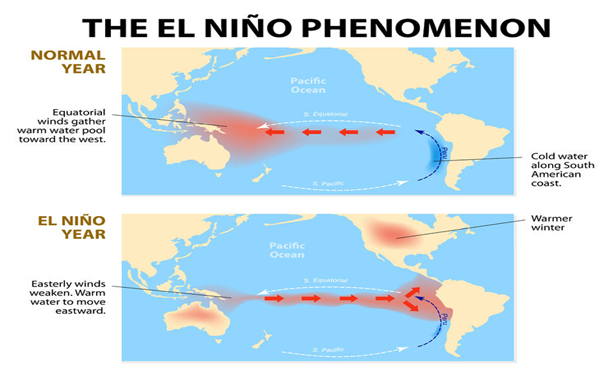Rare 3rd consecutive La Nina event underway
- Posted By
10Pointer
- Categories
Environment
- Published
29th Aug, 2022
-
Context
Australia’s Bureau of Meteorology (BOM) predicted that a third consecutive event of La Nina could be underway, leading to additional rainfall along its east coast this summer.

About La Nina
- La Nina means ‘little girl’ in Spanish and is also known as El Viejo or ‘cold event’.
- La Nina happening in two consecutive years is called ‘Double Dip’.
- La Nina events represent periods of below-average sea surface temperatures across the east-central Equatorial Pacific.
- The La Nina event is observed when the water temperature in the Eastern Pacific gets comparatively colder than normal, as a consequence of which, there is a strong high pressure over the eastern equatorial Pacific.
- La Nina events are also associated with rainier-than-normal conditions over south-eastern Africa and northern Brazil.
- In the ‘La Nina year’, rainfall associated with the summer monsoon in Southeast Asia tends to be greater than normal, especially in northwest India and Bangladesh.
- This generally benefits the Indian economy, which depends on the monsoon for agriculture and industry.
- La Nina causes drought in Peru and Ecuador, heavy floods in Australia, high temperatures in Western Pacific, Indian Ocean, off the Somalian coast and good monsoon rains in India.
- A La Nina is actually beneficial for the Indian monsoon.
- The combined phases of La Nina and El Nino are termed as El Nino-Southern Oscillation (ENSO) that affect rainfall patterns, global atmospheric circulation and atmospheric pressure across the planet.
About El Nino
- El Nino means ‘little boy’ or ‘Christ child’ in Spanish.
- El Nino soon came to describe irregular and intense climate changes rather than just the warming of coastal surface waters.
- The phenomenon was thus named because it was first recognised by South American fishermen in the early part of the 17th century.
- The events, i.e., warm waters in the Pacific Ocean, tended to occur in December, hence, the name was chosen.
- The El Nino event is not a regular cycle; they are not predictable and occur irregularly at two- to seven-year intervals.
- Normally, strong trade winds blow westward across the tropical Pacific, the region of the Pacific Ocean located between the Tropic of Cancer and the Tropic of Capricorn.
- El Nino causes drought-like conditions in India.
- El Nino refers to the large-scale ocean-atmosphere climate interaction linked to periodic warming in sea surface temperatures across the central and east-central Equatorial Pacific.
- It is associated with high pressure in the western Pacific.
- El Nino adversely impacts the Indian monsoons and hence, agriculture in India.
- Generally, El Nino and La Nina occur every 4 – 5 years.
- El Nino is more frequent than La Nina.
- Typically, the episodes last for nine to twelve months.
El Nino and La Nina’s Effects on India
- Since 1950, out of the 13 droughts that India faced, 10 have been during El Nino years and one in a La Nina year.
- This is because in general, an El Nino means lesser than average rains for India.
- Indian agriculture is heavily dependent on the monsoons and because of this, lesser rainfall during the monsoons generally translates to below-average crop yields.
- El Nino and La Nina or the ENSO is a very important concept in climatology in Geography.
- Since the phenomenon affects India and global weather conditions.
